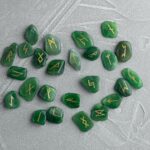Get ready to dive into the captivating world of blue sapphires, as we embark on a journey filled with fun and fascinating facts. As an experienced gemologist and jewelry enthusiast, I am here to unveil the mesmerizing stories and intriguing history behind these precious gemstones. From their enigmatic origins to their symbolic significance, be prepared to be enchanted by the allure of blue sapphires. So sit back, relax, and let’s unravel the secrets hidden within these breathtaking gems.

Blue Sapphire Fun Facts
Blue sapphires have long held a special place in the world of gemstones, captivating hearts with their mesmerizing allure. Let’s delve into some fascinating fun facts about these enchanting gemstones.
1. The Origins of Sapphire
The word “sapphire” originates from the Greek word “sappheiros,” which once referred to the brilliant blue stone, Lapis Lazuli. Over time, this name evolved to represent the stunning gemstone we know today as blue sapphire.
Did you know? The captivating blue hue of sapphires results from impurities in the mineral corundum, which is otherwise transparent. This is what makes blue saphire so unique and alluring.
2. Unmatched Durability
Blue sapphires are renowned for their exceptional durability. Scoring a remarkable 9 out of 10 on the Mohs Scale of Hardness, they stand second only to diamonds in terms of hardness. So, if you’re looking for a gemstone that will stand the test of time, blue sapphire is an ideal choice.
Pro tip: Blue sapphires can be worn daily without fear of damage, making them perfect for jewelry pieces that hold sentimental value.
3. Royal Love and Symbolism
Blue sapphires hold a rich history as symbols of love and royalty. Perhaps the most famous examples are the engagement rings of Lady Diana and Kate Middleton, which were adorned with magnificent blue sapphires. These gemstones have long been associated with qualities like loyalty, faithfulness, and wisdom.
Remember: Blue sapphires symbolize a deep and enduring love, making them an excellent choice for engagement rings or sentimental gifts.
4. The Alluring Cornflower Blue
When it comes to blue sapphires, the most sought-after shade is the rich cornflower blue. This captivating hue is highly desirable due to its vibrant and intense color saturation. The cornflower blue sapphire has a magical quality that can instantly captivate beholders.
Did you know? Sapphires can exhibit pleochroism, meaning they can display different colors when viewed from different angles. This adds to their allure and makes each sapphire a unique gemstone.
5. Origins and Locations
Sapphires can be found in various parts of the world, but one of the most prominent sources is the beautiful island nation of Sri Lanka. Sri Lanka is considered the oldest known source of sapphires in the Western world. These precious gemstones form as granular or massive habits, each with its own unique characteristics.
Fun fact: The largest and most valuable sapphire ever discovered was found in Sri Lanka. Its stunning size and rarity make it a true marvel of nature.
6. Sapphire Powers and Chakra Activation
In addition to their beauty, blue sapphires are believed to possess mystical qualities. They are said to activate the third eye chakra, enhancing wisdom, intuition, and integrity. Wearing blue sapphire jewelry can help you tap into the power and protection that these gemstones are believed to provide.
Pro tip: If you’re seeking to awaken your inner wisdom and deepen your spiritual journey, consider incorporating blue sapphires into your accessories.
7. The Timeless Appeal of Blue Sapphires
Throughout history, blue sapphires have fascinated civilizations with their timeless beauty. The ancient Etruscans prized sapphires, and their allure has continued to capture the hearts of people across cultures and time periods. Associated with royalty and dignity, blue sapphire is a gemstone that exudes power and elegance.
To sum up: The enchanting beauty, enduring hardness, and rich symbolism of blue sapphires make them a truly extraordinary gemstone. Whether worn as jewelry or treasured for their metaphysical properties, these gems have an undeniable allure.
So, next time you find yourself admiring a stunning blue sapphire, remember the fascinating fun facts that lie beneath its surface. And let these gemstones continue to inspire and captivate you with their timeless beauty and magnificent history.
Table:
markdown
| Fun Fact |
|——————————————————-|
| Blue sapphires derive their color from impurities in corundum, creating their captivating blue hue. |
| Blue sapphires rank 9 out of 10 on the Mohs Scale of Hardness, just below diamonds in durability. |
| Famous engagement rings, such as those of Lady Diana and Kate Middleton, feature dazzling blue sapphires. |
| The most desirable color for blue sapphires is the rich cornflower blue hue. |
| Sri Lanka is considered the oldest known source of sapphires in the Western world. |
| Blue sapphires can enhance wisdom and activate the third eye chakra. |
| Sapphires have been treasured throughout history for their association with royalty and dignity. |
markdown
Blue sapphires are not only stunning gemstones but also hold a wealth of intriguing history and folklore. If you’re curious about these mesmerizing gemstones and want to discover some fun facts about blue sapphire, click here to unveil a hidden world of knowledge and fascination. You’ll be amazed by the secrets that lie within these magnificent gems. So, why wait? Explore the realm of blue sapphires and unlock the mysteries that have captivated generations. Further information can be found at fun facts about blue sapphire.
FAQ
Q: Where does the word “sapphire” come from?
A: The word “sapphire” originates from the Greek word “sappheiros,” which initially referred to another blue stone called Lapis Lazuli.
Q: How durable is a blue sapphire compared to other gemstones?
A: Blue sapphire is one of the most durable elements in the world, scoring 9 out of 10 on the Mohs Scale of Hardness. It can only be scratched by a diamond.
Q: How does a blue sapphire get its color?
A: Blue sapphires get their color from impurities in the mineral corundum, which is otherwise transparent. The inclusion of iron and titanium minerals gives them their captivating blue hue.
Q: What are some rare and desirable colors of sapphires?
A: The rarest colors of sapphires are known as “padparadscha” and cornflower blue. These hues are highly sought after by collectors and enthusiasts.
Q: Where can sapphires be found?
A: Sapphires can be found in various locations, but one of the most well-known sources is Sri Lanka. Sri Lanka is considered the oldest known source of sapphires in the Western world, and sapphires found there can exhibit granular or massive habits.
- Unveiling the Enigma: Mansoureh Khojasteh Bagherzadeh’s Public Appearances & Private Life in Iran - July 18, 2025
- Unveiling the Mystery: Mansoureh Khojasteh Bagherzadeh’s Husband: A Rare Glimpse into a Private Life - July 18, 2025
- Unveiling Masoud Khamenei’s Mother: Power, Influence, and Iran’s Future - July 18, 2025
















